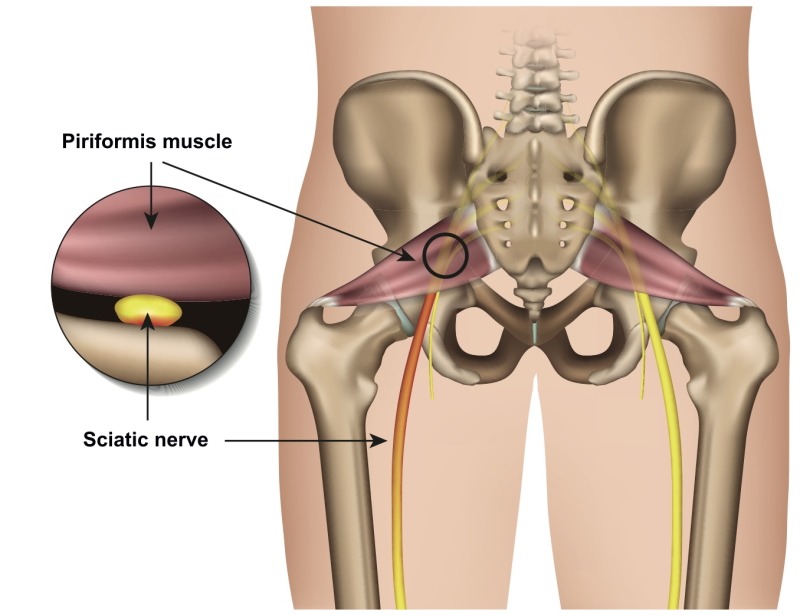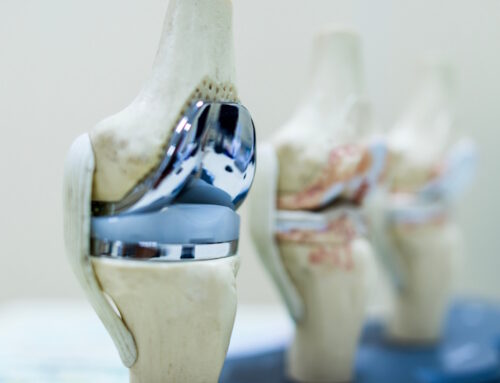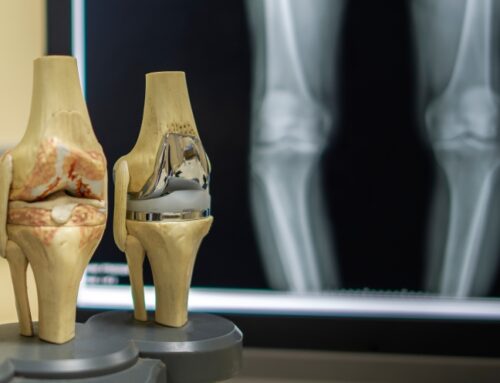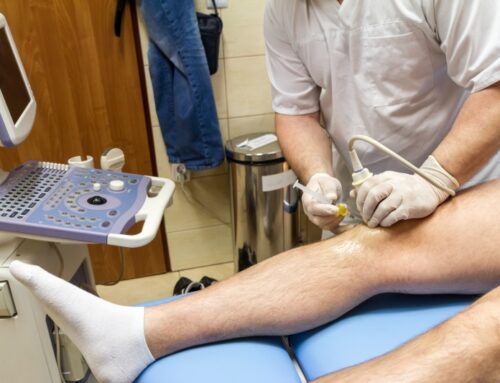Piriformis syndrome is a chronic condition arising from the piriformis muscle. This muscle causes pain locally in the buttocks. However, given its closeness to the sciatic nerve, we think it also irritates it. So, what is piriformis syndrome, and how can you treat it? Does a piriformis ultrasound injection help?
What is the piriformis muscle?
This muscle is located at the back of the hip joint. Its primary function is to rotate the hip to the outside (external rotation). But, importantly, the large sciatic nerve that supplies the lower leg leaves the buttock by passing under the muscle. So, we think part of the piriformis syndrome is related to nerve irritation as it passes under the piriformis muscle.
Possible causes
Although somewhat controversial, we think the tightness of the piriformis muscle can lead to problems. For example, some people have an anatomical variation where the muscle and nerve are close together or tethered. So, we suspect that the muscle can irritate the nerves in these people.
Symptoms of piriformis syndrome

Common symptoms of piriformis syndrome include:
- pain in the buttocks
- pins and needles and numbness in the lower leg
- tenderness on pressing of the muscle and reproduction of pain with pressure
Overall, seeing a doctor to confirm the cause of buttock pain is essential.
In general, there are many causes of buttock pain in sportspeople. Piriformis syndrome is a diagnosis of exclusion when other conditions are ruled out. The pathology that can mimic piriformis syndrome includes hip arthritis, sciatica, and hamstring tendonitis.
Often, we use an MRI scan to see the soft tissue in the buttock and rule out nerve pinching from the spine. Also, nerve studies may help confirm sciatic nerve irritation from the piriformis muscle.
Sometimes, we inject the piriformis muscle to help diagnose complex cases. If we inject the muscle and the pain disappears, we can be confident that the pain is coming from the piriformis. In general, we do this injection with ultrasound to increase accuracy.
Piriformis vs sacroiliac joint pain
Often, it is difficult to know whether buttock pain is coming from the piriformis or the sacroiliac joint. This is because these two structures sit close together. Sometimes, both structures can cause buttock pain.
Generally, sacroiliac joint pain is tender at the joint – which is more to the centre than the piriformis muscle. Also, specific tests (such as Ober or posterior draw test) can bring on the pain. MRI scans frequently point to degenerative changes in the sacroiliac joint, such as swelling or spur formation.
Sometimes, we treat both structures if we think both are coming from both.
Piriformis vs deep gluteal syndrome
Deep gluteal syndrome encompasses all the causes of sciatic nerve irritation from the piriformis to the upper hamstring. Trapping of the sciatic nerve at the piriformis is called piriformis syndrome. Other sites of trapping of the sciatic nerve include the obturator internus or the hamstring origin tendon (due to high hamstring tendonitis)
Treatment of piriformis syndrome

Generally, piriformis syndrome is a complex condition to treat. Therefore, it is essential to individualise treatment based on what works for each person.
Firstly, exercise therapy to strengthen the muscles behind the hip is essential. Secondly, stretching exercises to relieve muscle tightness can also be effective. Examples of Yoga stretching exercises include the pigeon, thread the needle, and butterfly. You must stop if you feel severe pain with these stretches. Thirdly, we use soft tissue therapy and acupuncture to reduce muscle tightness. Finally, a cortisone injection into the piriformis muscle can help with the treatment.
Surgery to release the sciatic nerve from the piriformis muscle is done in rare cases. However, surgery should only be considered when other simple treatments fail.
More about piriformis ultrasound injection
Generally, a piriformis ultrasound injection reduces pain from the piriformis muscle. Injecting the piriformis muscle helps to ease pain and improve rehab. Usually, we inject a combination of local anaesthetic and low-dose cortisone. Also, injections for piriformis syndrome should be done under ultrasound guidance to make them more accurate and effective.
How are piriformis ultrasound injections done?
Piriformis ultrasound injections are done after the consultation and only take 15-20 minutes.
First, we visualise the piriformis muscle in the buttock below the sacroiliac joint. Then, we carefully place the tip of a spinal needle into the muscle from lateral to medial. We need to be careful not to touch the nerve with the needle. Finally, we inject a small volume of local anaesthetic, sterile water and low-dose cortisone into the muscle.
Final word from Sportdoctorlondon about piriformis syndrome
Overall, we need to be cautious about diagnosing piriformis syndrome. This condition is a diagnosis of exclusion only. We recommend you see your doctor to rule out other causes. Finally, most treatments aim at improving stability around the hip and flexibility of the hip muscles. In some cases, piriformis ultrasound injections will help.








I am experiencing pain in the back and side of my leg as well as sciatica pain often.
Was going to wonderful sports medicine doctor who helped me a lot. Unfortunately does not take my coverage.Also, stretched and flexing my foot stretch relieves my discomfort. Would finding another in my plan be my best coarse of treatment?
Thank you
Lorraine
I think so. Yes.
Unbearable pain. Use the Acu-hump massager to relax the piriformis muscle for pain relief